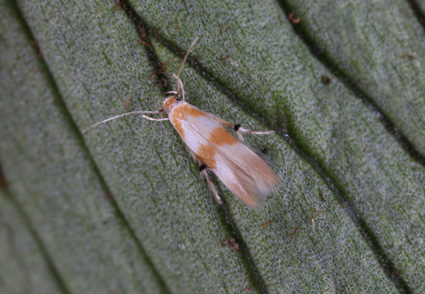Abstract
Pachyrhabda citrinacma Meyrick, 1936, an endemic species to Formosa (Taiwan), was named by Edward Meyrick based on two specimens collected by Syuti Issiki. Despite some newly discovered stathmopodids exhibiting characteristics matching the original description, the lack of information regarding the type specimen depository led to the species remaining elusive since its initial naming. In this study, we successfully rediscovered a P. citrinacma specimen at the Insect Museum of National Taiwan University, where Syuti Issiki used to conduct research. The present article provides comprehensive morphological details for both sexes, as well as unveiling the genitalia characters and life history of this species for the first time. Larvae feed on spores of a range of fern species belonging to a few different families.
References
- Clarke, J.F.G. (1955) Catalogue of the type-specimens of Microlepidoptera in the British Museum (Natural History) described by Edward Meyrick. Vol. 1. Natural History Museum (London) Publications, London, 332 pp. [pp. 1–3]
- Common, I.F.B. (1990) Moths of Australia. Melbourne University Press, Carlton, Victoria, 535 pp. https://doi.org/10.1071/9780643101227
- Fuentes-Jacques, L.J., Hanson-Snortum, P., Hernández-Ortiz, V., Díaz-Castelazo, C. & Mehltreter, K. (2022) A global review and network analysis of phytophagous insect interactions with ferns and lycophytes. Plant Ecology, 223, 27–40. https://doi.org/10.1007/s11258-021-01187-5
- Frago, E., Dicke, M. & Godfray, H.C.J. (2012) Insect symbionts as hidden players in insect-plant interactions. Trends in Ecology and Evolution, 27 (12), 705–711. https://doi.org/10.1016/j.tree.2012.08.013
- Klots, A.B. (1970) Lepidoptera. In: Tuxen, S.L. (Ed.), Taxonomist’s glossary of genitalia in insects. Munksgaard, Copenhagen, pp. 115–130.
- Koster, J.C. & Sinev, S.Y. (2003) Family Stathmopodidae. In: Huemer, P., Karsholt, O. & Lyneborg, L. (Ed.), Microlepidoptera of Europe. Vol. 5. Apollo Books, Stenstrup, pp. 1–387. https://doi.org/10.1163/9789004473850_007
- Lees, D.C. & Zilli, A. (2019) Moths, Their biology, biodiversity and evolution. Natural History Museum, London, 57 pp.
- Meyrick, E. (1930–1936) Exotic Microlepidoptera. Vol. IV. Taylor and Francis, Marlborough, 617 pp.
- Mitter, C. & Winkler, I.S. (2008) The Phylogenetic Dimension of Insect-Plant Interactions: A Review of Recent Evidence. In: Tilmon, K. (Ed.), Specialization, Speciation, and Radiation. University of California Press, Los Angeles, California, pp. 240–263. https://doi.org/10.1525/california/9780520251328.003.0018
- Robinson, G.S. (1986) Edward Meyrick: an unpublished essay on phylogeny. Journal of Natural History, 20 (2), 359–367. https://doi.org/10.1080/00222938600770261
- Sánchez-Bayo, F. & Wyckhuys, K.A.G. (2019) Worldwide decline of the entofauna: A review of its drivers. Biological Conservation, 232 (2019), 8–27. https://doi.org/10.1016/j.biocon.2019.01.020
- Sawamura, M., Kawakita, A. & Kato, M. (2009) Fern-spore-feeder interaction in temperate forest in Japan: Sporing phenology and spore-feeding insect community. American Journal of Botany, 96 (3), 594–604. https://doi.org/10.3732/ajb.0800256
- Shen, Z.Y. & Hsu, Y.F. (2023) Rediscovering a species not seen for a hundred years, Stathmopoda tacita (Meyrick, 1913) (Lepidoptera, Stathmopodidae), with its unusual fern-spore-feeding life history. Biodiversity Data Journal, 11, e101468. https://doi.org/10.3897/BDJ.11.e101468
- Shen, Z.Y., Terada, T., Landry, J., Hoare, R.J.B., Kuo, L.Y., Chou, M.H., Hsu, Y.F. & Huang, J.P. (2024) Systematics and evolutionary dynamics of insect-fern interactions in the specialized fern-spore feeding Cuprininae (Lepidoptera, Stathmopodidae). Molecular Phylogenetics and Evolution, 194, 108040. https://doi.org/10.1016/j.ympev.2024.108040
- Shirozu, T. (1978) Remembering Professor Syuti Issiki. The Lepidopterological Society of Japan, 95–96, 3–5.
- Sinev, S.Y. (2015) World catalogue of bright-legged moths (Lepidoptera, Stathmopodidae). Zoological Institute of Russian Academy pf Science, St. Petersburg, 84 pp.
- Zimmerman, E.C. (1978) Insects of Hawaii. Vol. 9. Part 2. University Press of Hawaii, Honolulu, 1903 pp. [pp. 883–1903]


